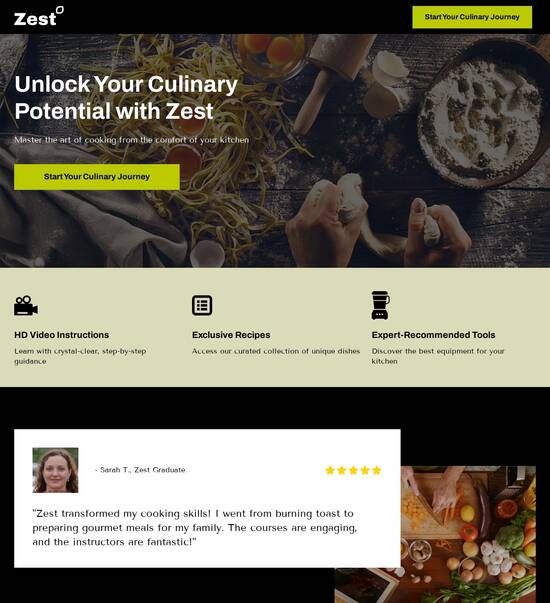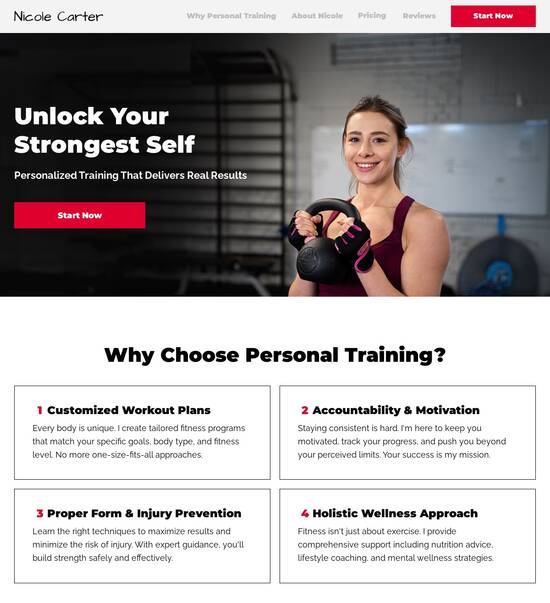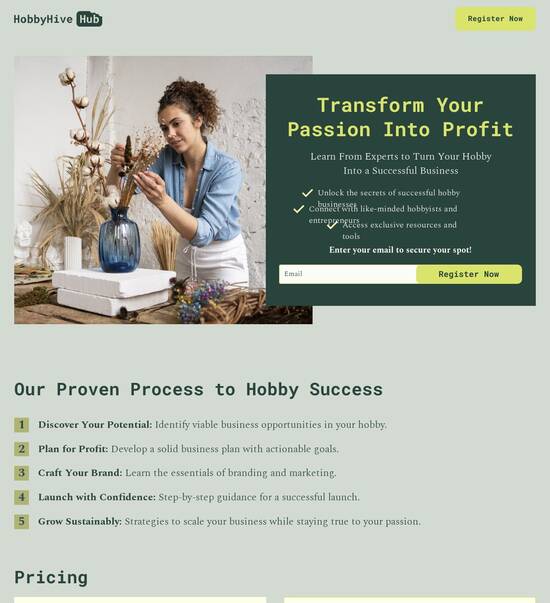
Glossary page template optimized for Digital photo frame
Explore Similar TemplatesAbout template
Design using a responsive glossary page template that delivers a flawless experience on Digital photo frame. Try Instapage today!
Recommended templates

Easy to build without coding
With the intuitive drag-and-drop builder, anyone on your team can create high-converting pages without any knowledge of code or design. Make enhancements to your landing page with custom widgets using Javascript, HTML/CSS, or third-party scripts.

Multiple layouts for any industry and goal
Select from 500+ landing page layouts built to boost conversions across industry-specific scenarios. Customize them by adjusting fonts, adding images, and generating on-brand content with the AI assistant. Quickly scale with Instablocks® and Global Blocks that you can save, reuse, and update globally.

Loads fast and looks polished on any device
Every template is responsive, which means they present professionally on any device and load blazingly fast with our Thor Render Engine. You can also power them up with Google AMP technology to deliver an unparalleled mobile experience and drive higher conversions.

Robust analytics & experimentation
Get real-time updates and reporting across all your devices, showing the number of visitors, conversions, cost-per-visitor, and cost-per-lead. Launch AI-powered experiments, run A/B tests, and use heatmaps to analyze user behavior, then optimize your landing page to maximize conversions.







Easy to build without coding
With the intuitive drag-and-drop builder, anyone on your team can create high-converting pages without any knowledge of code or design. Make enhancements to your landing page with custom widgets using Javascript, HTML/CSS, or third-party scripts.
Multiple layouts for any industry and goal
Select from 500+ landing page layouts built to boost conversions across industry-specific scenarios. Customize them by adjusting fonts, adding images, and generating on-brand content with the AI assistant. Quickly scale with Instablocks® and Global Blocks that you can save, reuse, and update globally.
Loads fast and looks polished on any device
Every template is responsive, which means they present professionally on any device and load blazingly fast with our Thor Render Engine.
Robust analytics & experimentation
Get real-time updates and reporting across all your devices, showing the number of visitors, conversions, cost-per-visitor, and cost-per-lead. Launch AI-powered experiments, run A/B tests, and use heatmaps to analyze user behavior, then optimize your landing page to maximize conversions.
All the features you need to build lead-generating landing pages
Explore more featuresLearn how to build top-performing landing pages for any goal
FAQs
Leading the way in building high-performing landing pages





An ultimate guide to landing page optimization with Instapage
Creating high-converting landing pages is essential for the success of any digital marketing campaign. With Instapage, marketers can leverage powerful tools designed to enhance conversion rates, streamline processes, and maximize ROI. This guide will explore step-by-step strategies for effective landing page optimization using Instapage, tailored specifically for marketers in sectors like business services, tech, education, and more.
Understanding landing pages
Landing pages serve as the focal point for your marketing efforts. They are designed specifically to capture leads and convert visitors into customers. It's crucial for marketers to understand the anatomy of an effective landing page, as this knowledge can significantly impact the performance of their campaigns. Successful landing pages not only attract attention but also encourage visitors to take action, whether that means signing up for a newsletter, registering for a webinar, or making a purchase. Instapage provides a robust platform with 100+ templates and intuitive builders, making it easier than ever to create tailored landing pages.
- High-converting templates: Utilize Instapage's pre-built designs to save time and ensure effective layouts.
- Lead generation elements: Include contact forms, buttons, and engaging visuals to drive conversions.
- Responsive design: Ensure your pages perform well across all devices to cater to a wider audience.
Step 1: Creating an effective landing page
The first step in landing page optimization is constructing a strong foundation. Start by choosing a template that aligns with your campaign’s goals. Once you have a solid base, customize it to fit your brand's tone and messaging. Consider the following:
- Personalization: Use dynamic text replacement to tailor content to specific audience segments.
- Ad alignment: Integrate AdMaps to ensure your ads lead to relevant landing pages, enhancing user experience.
- Clear CTA: Create compelling calls-to-action that clearly inform users what steps to take next.
Step 2: Optimize for performance
After constructing your landing page, it's crucial to optimize for performance to ensure high conversion rates. Utilize Instapage's built-in experimentation features to conduct A/B tests. This allows you to compare different versions of your landing page and make data-driven decisions based on user behavior.
- Heatmaps: Analyze where users are clicking to understand on-page behavior.
- Analytics dashboard: Monitor performance metrics to assess the effectiveness of your landing page.
- Continuous testing: Regularly update and test your landing page to keep up with changing user preferences.
Step 3: Collaborate for success
Collaboration is key in creating effective landing pages. Instapage offers features that facilitate real-time feedback and secure sharing with stakeholders. This speeds up the review process and allows for quick adjustments before launching your campaign.
In conclusion, optimizing landing pages using Instapage's tools can significantly impact your digital marketing strategies and overall ROI. By following these steps, marketers can create high-performing landing pages that cater specifically to their audiences and drive conversions.
Ready to take your landing page optimization to the next level? Sign up for Instapage today and start transforming your marketing campaigns.
People also ask about Glossary page template optimized for Digital photo frame
Glossary page template optimized for digital photo frames
The essence of a glossary page template for digital photo frames
A glossary page template specifically designed for digital photo frames serves as a crucial component for organizing terminology in a user-friendly manner. Glossaries are vital for enhancing the learning experience, providing concise definitions and contextual understanding of terms that may be unfamiliar. By compiling essential terms relevant to the content displayed, users can engage more effectively with their digital photo frames, unlocking deeper meanings and connections.
User engagement is significantly enhanced through a well-structured glossary. When users can clearly see definitions alongside visual content, it not only fosters a richer understanding but also encourages exploration. Glossary pages are more than mere lists; they transform information into an interactive experience that keeps users returning for more insight.
The unique role of digital photo frames
Digital photo frames are versatile tools found in various settings, from homes and offices to events and exhibitions. Unlike traditional photo displays, these frames can showcase dynamic content, and integrating a glossary enhances their functionality. Whether displaying family photos, corporate presentations, or event highlights, the ability to define and explain elements enriches the viewer's experience.
Moreover, digital photo frames often evoke emotional connections. They are not just about displaying images; they tell stories and share memories. A glossary page that complements visual storytelling can deepen these connections by providing context and background, making the storytelling process much more intimate and meaningful.
Key features of a glossary page template
A well-crafted glossary page template should incorporate key features to enhance usability. First and foremost, interactive navigation is essential. Users appreciate clickable terms that lead them directly to definitions, allowing for a fluid exploration of content without needing to search manually. Features such as a search bar also make it easier for users to locate specific terms quickly, ensuring an efficient navigation process.
Visual integration is another critical aspect. The design should align with the aesthetics of the digital photo frame, using color palettes and typography that match the display. Additionally, incorporating relevant images along with definitions can provide visual cues that not only help in understanding the terms but also enhance the overall look of the glossary page.
Optimized layouts are necessary for the growing variety of screen sizes in digital photo frames. Templates should be adaptive, providing a seamless experience whether the user accesses it on a small display in a cozy home environment or on a large screen at a business presentation. Tailoring user-friendly interfaces to accommodate diverse audiences improves accessibility and encourages more users to engage with the glossary content.
Innovative technologies behind the template
Responsive design principles play a crucial role in the development of glossary templates. As technology evolves rapidly, ensuring that these templates adapt to new digital photo frame capabilities is essential. A flexible design allows for the addition of new technologies over time, contributing to the longevity and relevance of the glossary page.
Multimedia utilization can take glossary pages to the next level. By incorporating video and audio elements, definitions can be explained in a more engaging manner. Interactive media enhances user participation, allowing users to not only read definitions but also listen to explanations or watch illustrative videos that clarify complex terms.
Data management tools further enhance the experience by automating updates for terms and definitions. When integrated with cloud-based systems, users can access a constantly updated glossary, ensuring they always have the latest information available. This is particularly useful in dynamic settings like corporate environments, where terms and jargon can frequently evolve.
Enhancing content through community collaboration
Community collaboration can significantly enrich the glossary page's content. By building a knowledge base that crowdsources contributions from users and experts, the glossary becomes a living document that evolves with its users. This collaborative approach encourages diverse viewpoints and interpretations, making the content more comprehensive and relatable.
Moreover, facilitating a Q&A platform within the glossary can lead to collective learning. Users can share experiences related to specific terms, further enhancing understanding. Highlighting community-driven updates keeps the glossary dynamic, allowing it to grow organically based on user interactions and contributions.
Optimizing user experience and access
Tailoring access permissions within the glossary can enhance user experience significantly. It is essential to designate specific roles for contributors, editors, and general users. This level of control ensures that content accuracy is maintained while also allowing enthusiastic users to contribute. Implementing security measures for information integrity not only protects the glossary but also fosters trust among users.
Previews and testing are vital steps prior to full deployment. Live demos can enable users to interact with the glossary, providing feedback that can lead to improvements in content and layout. Establishing feedback loops helps refine the glossary, ensuring it meets the needs of its users and provides a positive user experience.
Structuring answers for common glossary questions
Standardization of terminology ensures that the glossary remains consistent and relevant. Defining terms uniformly across related fields helps users understand the context better. This standardization is also critical in ensuring that definitions are accurate and trustworthy, often referencing authoritative sources to maintain credibility.
Addressing user needs through an analysis of frequently asked questions can guide the content creation process. By understanding the terms that users struggle with or are curious about, the glossary can be tailored to meet those demands. Establishing a feedback mechanism for continual improvement allows users to suggest additional terms or clarifications, keeping the glossary responsive to their needs.
The impact of teams and collaborations
Integrating cross-functional teams in the development of a glossary page template enhances the overall quality of the content. Each team member, from designers to content creators and tech experts, brings a unique perspective that contributes to a more polished final product. This collaborative effort enhances workflow, streamlining production and ensuring that the glossary meets both aesthetic and functional goals.
Additionally, establishing peer review processes is crucial for maintaining accuracy. Verification systems for definitions by team members help build the glossary's credibility. By fostering a culture of collaboration, teams can ensure high-quality content that is trustworthy and useful for the end-users.
The future of glossary pages in digital photo frames
As user expectations continue to evolve, glossary pages in digital photo frames must adapt. The landscape of digital content consumption is shifting, prompting a need for more interactive and engaging formats. Future glossary pages may incorporate augmented reality features, allowing users to view definitions and context in a more immersive environment that blends seamlessly with the displayed images.
A long-term vision for glossary templates involves continuous content enhancement strategies. Periodically refreshing definitions and including user-generated content will keep the glossary relevant and appealing. Predicting future functionalities, such as incorporating AI for personalized user interactions, can set the standard for how glossary pages develop in digital displays.
Practical applications of glossary pages in various locations
The integration of glossary pages in digital photo frames can serve various practical applications across different locations. In event settings, these pages can function as live informational resources, providing attendees with quick access to definitions related to the showcased content. This not only serves as an educational tool but also cultivates discussions among participants, enriching the overall experience.
In personal and corporate settings, glossary pages can further personalize the experience. For home users, creating personalized photo frames with family definitions adds emotional value. In corporate environments, using glossaries for training and onboarding materials can help standardize terminology, promoting a consistent understanding among new hires, enhancing their integration into the company culture.
Evaluating the benefits of a glossary page template
The benefits of a glossary page template extend beyond mere definition listings. By enhancing user literacy, these pages bridge knowledge gaps, empowering users to engage in a deeper dialogue with the displayed content. When users feel equipped with understanding, their interactions become richer, and they are more inclined to explore further.
Moreover, a well-structured glossary boosts user engagement significantly. Clear definitions retain users' attention, encouraging repeated interactions with digital photo frames. By providing a supportive environment for learning and exploration, glossary pages become essential tools for enhancing overall user satisfaction and fostering a culture of continuous learning.
Ready to skyrocket conversions?
Supercharge your ad campaigns with high-performing landing pages
Get started














